Original Article - (2017) Volume 18, Issue 3
Departments of 1Gastroenterology and Hepatology, 2Endoscopic Diagnostics and Therapeutics, 3Pathology, and 5Surgery, Kochi Medical School, Kochi University, Nankoku, Kochi 783-8505, Japan 4Department of Surgery, Matsuyama Shimin Hospital, Matsuyama, Ehime 794-0067, Japan
Received March 06th, 2017-Accepted March 29th, 2017
Context SCGB1D2 is a member of the secretoglobin superfamily, but little is known about the functional and prognostic value of this protein in pancreatic cancer. In the current study, we investigated the expression pattern and underlying clinical significance of SCGB1D2 in pancreatic cancer. Methods Immunohistochemistry was performed to determine whether high SCGB1D2 expression in 102 resected pancreatic cancer tissues was correlated with poor patient prognosis. Immunocytochemistry was also performed to determine the intracellular distribution of SCGB1D2. To determine whether SCGB1D2 participated in the formation of cell protrusions and the accumulation of peripheral actin-filaments in pancreatic cancer cells, SCGB1D2 expression was transiently suppressed by small-interfering RNA knockdown. Results Kaplan-Meier analysis showed that pancreatic cancer patients with higher SCGB1D2 expression exhibited a remarkably shorter overall survival. Importantly, univariable and multivariable Cox regression analysis revealed that SCGB1D2 protein expression level was a significant and independent prognostic factor for overall survival in these patients. However, no correlation was found between SCGB1D2 expression and clinicopathological parameters. Membranous expression of SCGB1D2 in pancreatic cancer cells was found in 36.3% of pancreatic cancer patients, but was not an independent risk factor for progressive disease and death. Membranous SCGB1D2 expression was found to be associated with histology grade but no other clinicopathological parameters. Immunocytochemistry demonstrated that SCGB1D2 was localized to the cell protrusions of migrating pancreatic cancer cells. Knockdown of SCGB1D2 decreased the formation of these protrusions, but the effect could be abrogated by co-transfection with an SCGB1D2-rescue construct. Conclusions SCGB1D2 is an unfavorable biomarker of prognosis in pancreatic cancer and plays a role in the formation of cell protrusions important for cancer cell migration.
Pancreatic Neoplasms; Prognosis; Secretoglobins
Pancreatic ductal adenocarcinoma (PDAC) is the fourth most common cause of cancer death in the Western world [1]. The prognosis is poor, with 1- and 5-year survival rates of only 20% and 6%, respectively [2]. Early diagnosis of PDAC is difficult, and there are no blood biomarkers to identify patients with pancreatic cancer at an early stage [3]. Therefore, new insights into the biology and genetics of PDAC are required to identify novel markers for diagnosis and prognosis prediction, and the development of targeted therapies.
SCGB1D2 (Secretoglobin, Family 1D, Member 2), also termed lipophilin B, is a member of the secretoglobin (SCGB) supergene family [4]. Secretoglobins are secreted proteins of small molecular weight belonging to a polypeptide family that includes at least nine family members in humans [5, 6]. Although the first SCGB polypeptide, uteroglobin (SCGB1A1), was discovered more than 30 years ago, the pathophysiological functions of the family are still poorly understood. SCGB1D2 is generally located in secretory epithelia such as that found in breast tissue [7], and its dysregulated expression has been reported in several malignancies, including breast [8] and gynecological cancers [9]. We recently reported that insulinlike growth factor-2 mRNA-binding protein 3 (IGF2BP3), can bind to ADP-ribosylation factor 6 (ARF6) and Rho guanine nucleotide exchange factor 4 (ARHGEF4) messenger RNAs (mRNAs), leading to their accumulation in the cell protrusions of PDAC cells [10]. In turn, these locally translated proteins influence the formation of additional membrane protrusions and thereby increase the motility and invasiveness of PDAC tumors [10, 11]. Since IGF2BP3 also binds SCGB1D2 mRNA [10], these findings suggest that SCGB1D2 translated within cell protrusions may also be associated with cell invasion and metastasis. However, little is known about the relationship of SCGB1D2 expression in regard to clinicopathological parameters and prognosis in PDAC patients.
In this study, we analyzed the expression of the SCGB1D2 protein in human PDAC tissues using immunohistochemistry and immunocytochemistry, and evaluated the relationship of SCGB1D2 expression with corresponding clinicopathological parameters and patient prognosis. SCGB1D2 was found to accumulate in cell membrane protrusions, indicating that this protein plays an important role in their formation. Importantly, our results suggest that high expression of SCGB1D2 is a reliable indicator for poor prognosis in PDAC patients.
Primary Human PDAC Samples
Patients (n = 102) who underwent surgical treatment for PDAC at the Departments of Surgery, Kochi Medical School Hospital (Nankoku, Japan) and Matsuyama Shimin Hospital (Matsuyama, Japan) between 1999 and 2014 were studied (clinicopathological findings of these 102 patients are summarized in Table 1), as published previously [12]. The follow-up period for survivors ranged from 18 to 192 months (median 64.0). Of these patients, 83 had received adjuvant chemotherapy with gemcitabine or S-1 (tegafur/ gimeracil/oteracil), or chemoradiation therapy after resection. Pancreatic carcinomas were classified according to the Japan Pancreas Society [13] and the Union for International Cancer Control (UICC) TNM staging notation [14]. Immunohistochemical analysis of PDAC samples was approved by the ethical review boards of Kochi Medical School and Matsuyama Shimin Hospital prior to patient recruitment, and was carried out in accordance with the approved guidelines. Informed consent was obtained from each patient.
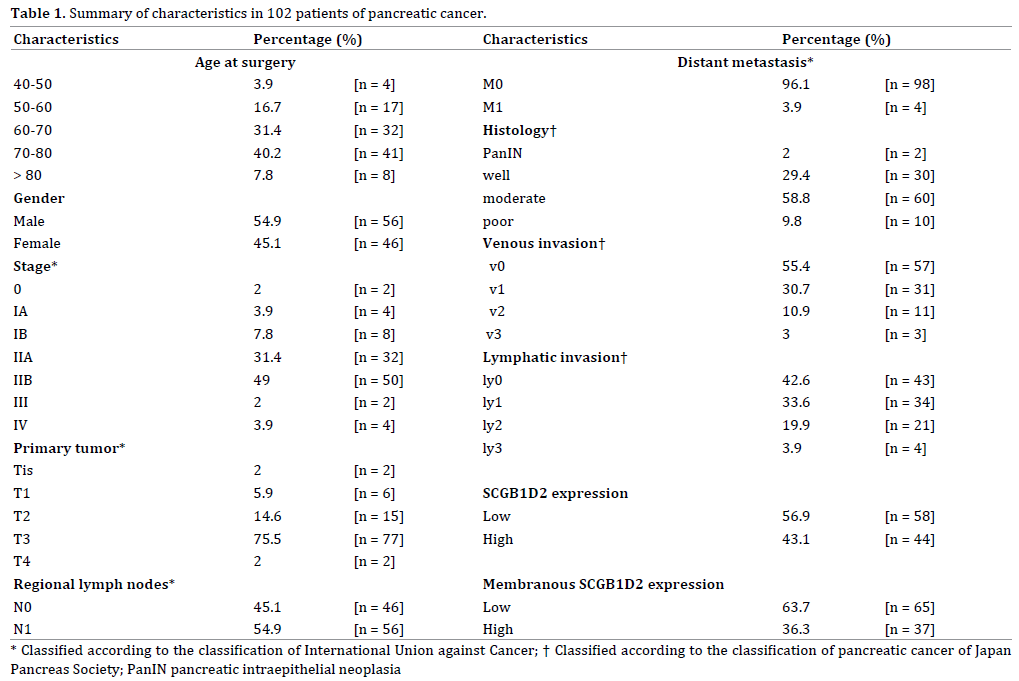
Immunohistochemical Staining
Immunohistochemistry was carried out, as published previously [12]. Tissue sections from normal pancreas, brain, lung, liver and kidney were purchased from Biochain (Hayward, CA). The sections were deparaffinized and autoclaved at 108°C for 15 min. After endogenous peroxidase activity was quenched by incubation for 30 min in 0.33% hydrogen peroxide diluted in methanol, the sections were incubated with fetal bovine serum for blocking. Sections were then incubated with anti-SCGB1D2 antibody (sc-48327; Santa Cruz Biotechnology, Santa Cruz, CA) at room temperature for 1 h and washed with PBS. Immunodetection was performed with peroxidaselabeled anti-rabbit immunoglobulin (DakoCytomation, Carpinteria, CA). Finally, the reactants were developed with 3,3’-diaminobenzidine (Dako), and the sections were counterstained with hematoxylin.
Evaluation of SCGB1D2 Staining
Staining was evaluated by one researcher (KT) with two independent observers (SN and MF), who were blinded to the clinical and outcome data, as published previously [12]. Immunoreactivity was scored semi-quantitatively according to the estimated percentage of positive tumor cells (1, <50% reacting cells; 2, 50% to 80% reacting cells; 3, >80% reacting cells) and the staining intensity (1, weaker than the intensity of staining on the surface of the islets of Langerhans; 2, equal to the intensity of staining of the islets of Langerhans; 3, stronger than the intensity of staining of the islets of Langerhans). Slides on which the islets of Langerhans did not stain significantly were considered to be in bad condition and were not evaluated. A total immunohistochemical score was calculated by summing the percentage score and the intensity score. The level of SCGB1D2 expression was classified into two groups according to the total score (score of 2-3, lowexpressing group; score of 4-6, high-expressing group). In addition, the distribution of SCGB1D2 expression in PDAC tissues was recorded as negative (0), weak cytoplasmic positivity in any proportion of cells (1), moderate cytoplasmic positivity in any proportion of cells (2), distinct membranous positivity in ≤ 50% of cells (3), and distinct membranous positivity in >50% of cells (4) as previously described [15, 16]. The level of membranous SCGB1D2 expression was then classified into two groups according to the total score (membranous score of 0-2, low-expressing group; membranous score of 3-4, highexpressing group).
Cell Culture
The human PDAC cell line S2-013, a subline of SUIT- 2, was obtained from Dr. T. Iwamura (Miyazaki Medical College, Miyazaki, Japan) [17]. The human PDAC cell line PANC-1 was purchased from the American Type Culture Collection (ATCC; Manassas, VA). All cells were grown in Dulbecco’s modified Eagle’s medium (DMEM; Gibco-BRL, Carlsbad, CA) supplemented with 10% heat-inactivated fetal calf serum at 37°C in a humidified atmosphere saturated with 5% CO2.
Immunocytochemistry Analysis by Confocal Immunofluorescence Microscopy
Immunocytochemistry was carried out, as published previously [12]. Coverslips were coated with 10 μg/mL fibronectin (Sigma-Aldrich, St. Louis, MO) for 1 h at room temperature. Cells were seeded on fibronectin-coated glass coverslips and incubated for 5 h. The cells were then fixed with 4% paraformaldehyde, permeabilized with 0.1% Triton X-100, covered with blocking solution (3% BSA/PBS), and then incubated with the primary antibody for 1 h. Alexa488- or Alexa594-conjugated secondary antibody (Molecular Probes, Carlsbad, CA) was then applied with Alexa594- or Alexa594-conjugated phalloidin (Cytoskeleton, Denver, CO). Each specimen was visualized using a Zeiss LSM 510 META confocal microscope (Carl Zeiss, Gottingen, Germany).
Small Interfering RNA Treatment
Individual mixtures of four different small interfering RNA (siRNA) oligonucleotides (oligos) targeting SCGB1D2 were purchased from Qiagen (FlexiTube GeneSolution siRNA GS10647; Valencia, CA), and individual mixtures of four different scrambled negative control siRNA oligos were obtained from Santa Cruz (37007). To examine the effect of the siRNAs on SCGB1D2 expression, S2-013 and PANC-1 cells were plated in six-well plates, and transfected 20 h later with 80 pmol of the relevant siRNA mixture in siRNA transfection reagent (Qiagen) following the manufacturer's instructions. After incubation for 48 h, the cells were processed for Western blotting or for immunocytochemistry analysis.
SCGB1D2-rescue Construct
Reverse transcription-PCR (RT-PCR) was used to amplify the entire coding sequence of the SCGB1D2 cDNA. The resultant PCR product was subsequently inserted into a pCMV6-Entry vector (Origene Technologies, Rockville, MD) bearing a C-terminal myc-DDK-tag. The X-tremeGENE HP DNA Transfection Reagent (Roche, Penzberg, Germany) was used to transiently transfect target cells with the resultant SCGB1D2-rescue construct. After incubation for 48 h, the cell pellet was resuspended in lysis buffer containing 20 mM HEPES (pH 7.4), 100 mM KCl, 2 mM MgCl2, 0.5% Triton X-100, protease inhibitor cocktail tablets (Roche), and phosphatase inhibitor cocktail (Nacalai, Kyoto, Japan). The bicinchoninic acid (BCA) assay was used to determine the protein concentration of each lysate, and an aliquot of each lysate was then diluted with sample buffer (50 mM Tris, 2% sodium lauryl sulfate (SDS), 0.1% bromophenol blue, and 10% glycerol) to a final concentration of 1-2 μg/ μL and analyzed by SDS-polyacrylamide gel electrophoresis and Western blotting using anti-SCGB1D2 (sc-48327; Santa Cruz Biotechnology) and anti-myc (sc-789; Santa Cruz Biotechnology) antibodies.
Statistical Analysis
Statistical analysis was carried out, as published previously [12]. StatFlex software (Ver. 6; YUMIT, Osaka, Japan) and SAS software (Ver. 9.1.3; SAS Institute, Cary, NC) were used for statistical analysis. Student’s t-test was used for the comparison of continuous variables. Fisher's exact test was used to assess the association between SCGB1D2 expression levels and clinicopathological parameters. The following parameters were examined: age, sex, and the TNM classification or pathological stage, based on the Japan Pancreas Society [13] and UICC [14] scoring systems. Overall survival time was measured from the date of surgery to the date of death (due to any cause) or the last clinical follow-up, as determined by review of electronic medical records. Survival curves were plotted using the Kaplan-Meier method and compared using the log-rank test (Mantel-Cox). Survival rates are expressed as the median value and interquartile range (IQR). Independent factors, including age, sex, and the pathological stage for overall survival, were assessed with Cox proportional hazards regression analysis. P values <0.05 were considered to be statistically significant, and all tests were two-tailed.
SCGB1D2 Expression in Human PDAC Tissues
We examined SCGB1D2 expression in surgical specimens from 102 patients with PDAC by immunohistochemical analysis. A histoscore method [12, 18], which takes into account both the extent of expression and the staining intensity of SCGB1D2, was employed. Expression levels of SCGB1D2 were evaluable in all 102 cases, and these cases were classified into low-expressing (56.9%, n = 58; total immunohistochemical score, 2-3) and high-expressing (43.1%, n = 44; total immunohistochemical score, 4-6) SCGB1D2 groups (Table 1). SCGB1D2 was localized to both the cytoplasm of PDAC cells (Figure 1a), and their cell membranes (Figure 1b). High levels of membranous SCGB1D2 (i.e. a membranous immunohistochemical score of 3-4) were found in 36.3% (n = 37) of patients (Table 1). There was no obvious staining with the SCGB1D2 antibody in the pancreatic ducts of normal pancreas, or in normal samples of brain, lung, liver and kidney (Figure 1c). The expression levels of intracellular SCGB1D2 and membranous SCGB1D2 were not different in the central region and the penumbra of the PDAC tumor.
Figure 1. SCGB1D2 expression in resected PDAC tissues.
(a). Immunohistochemical staining of PDAC tissues with anti-SCGB1D2, showing that SCGB1D2 is present in the cytoplasm of tumor cells (magnification 200×).
Scale bar, 50 μm. (b). Immunohistochemical staining of PDAC tissues with anti-SCGB1D2, showing membrane staining of SCGB1D2 in tumor cells (magnification
200×). Scale bar, 50 μm. (c). Expression of SCGB1D2 in normal pancreas, brain, lung, liver and kidney (magnification 200×). Scale bars, 50 μm.
Association Between SCGB1D2 Expression, Clinicopathology, and Overall Survival
We next analyzed the relationship between SCGB1D2 expression and clinicopathological features as shown in Table 2, however there was no significant correlation found between overall expression score and the clinicopathological features examined. Membranous SCGB1D2 expression was associated with histology grade, but there was no significant correlation between high-expressing membranous SCGB1D2 and other clinicopathological features (Table 3).
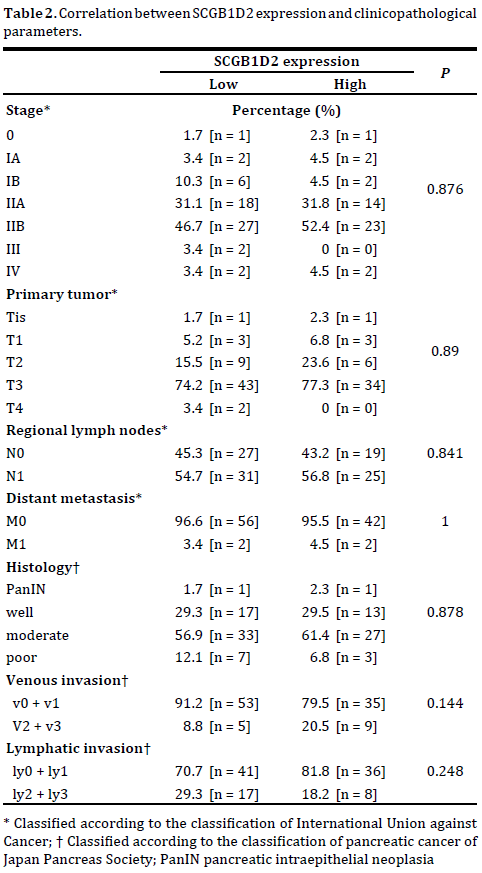
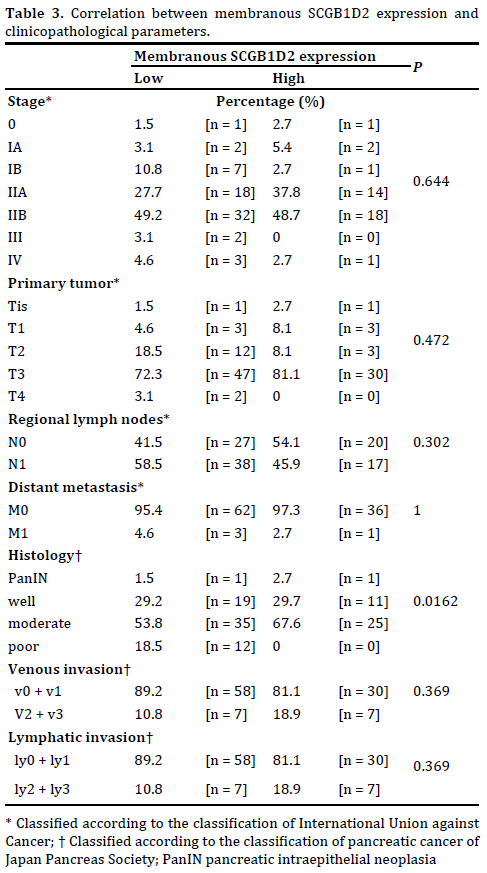
The follow-up period for survivors of the 102 PDAC patients ranged from 18 to 192 months (median 64.0). Median survival time was 26 months (95% confidence interval [CI], 23-33), the 3-year survival rate was 35.1% (95%CI, 25.6-44.8), and the 5-year survival rate was 25.9% (95%CI, 17.2-35.5). Kaplan-Meier plots showed there was a significant difference in overall survival rate (P = 0.007) between groups with high and low SCGB1D2 expression (Figures 2a, 2b), but not between groups with high and low membranous SCGB1D2 expression (P = 0.583; Figure 2c).
Figure 2. Association of SCGB1D2 expression with poor outcome in PDAC patients.
(a). Kaplan-Meier analysis of PDAC-specific survival and (b). overall survival according to SCGB1D2 expression. (c). Kaplan-Meier analysis of overall
survival rates in patients with high and low membranous SCGB1D2 expression. Scale bars, 10 μm.
Univariate and multivariate analyses were then used to assess the prognostic value of SCGB1D2 expression in PDAC. Stage III and IV UICC TNM classification (hazard ratio [HR], 3.035; 95% CI, 1.301-7.081; P = 0.010) and high SCGB1D2 expression (HR, 0.538; 95% CI, 0.337-0.857; P = 0.009) were found to be independent and significant prognostic factors for worse patient survival by univariate Cox regression analysis (Table 4). Multivariate survival analysis supported this finding, showing that Stage III and IV classification (HR, 13.77; 95% CI, 3.772-50.26; P < 0.001) and high SCGB1D2 expression (HR, 0.556; 95% CI, 0.342-0.903; P = 0.017) were again independent prognostic factors for poor survival (Table 4). The effects of Stage III / IV, and SCGB1D2 expression on overall survival were similar between univariate and multivariate analyses. Membranous SCGB1D2 expression however, was not found to be a significant prognostic factor for patient survival (Table 5).
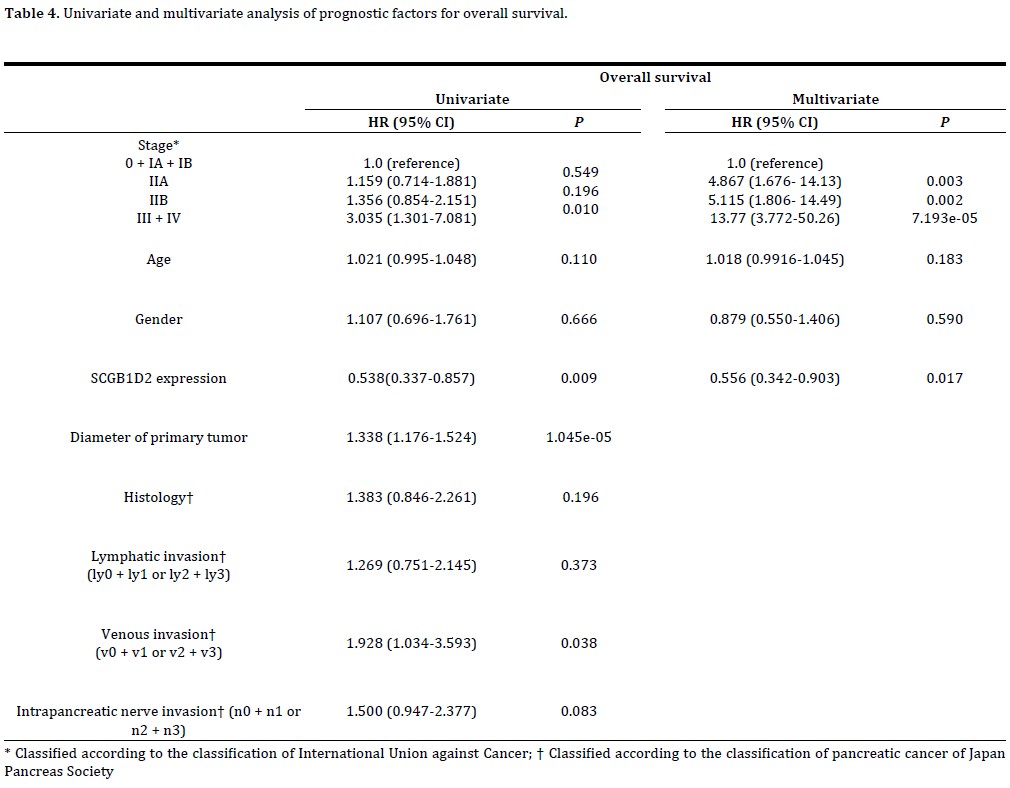
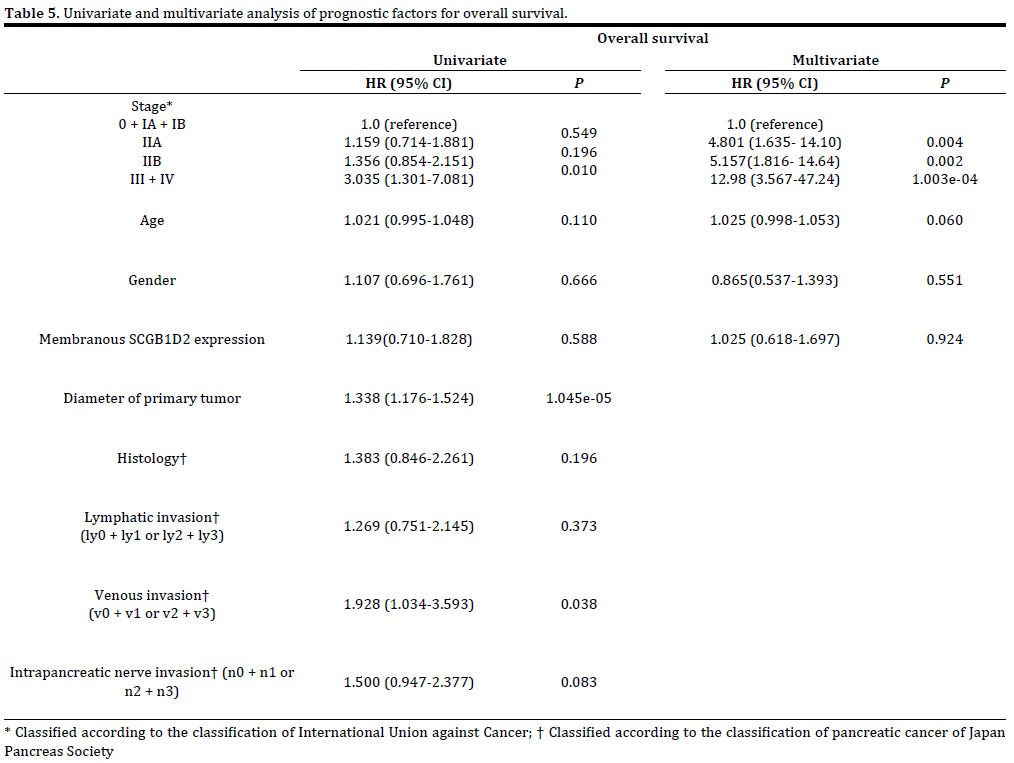
Localization of SCGB1D2 in Cell Protrusions
We used immunocytochemistry to determine the subcellular localization of SCGB1D2 in two types of cultured PDAC cells: moderately differentiated PDAC cells (line S2-013) [17] and cells from a poorly differentiated PDAC line (PANC-1) [19]. It has been previously reported that when S2-013 cells in a suspension attach to an immobilized fibronectin substrate, nascent membrane protrusions with de novo actin patches at the cell periphery form, and as these protrusions mature, they promote cell motility [20, 21]. It has also been reported that both S2- 013 and PANC-1 cells form fewer membrane protrusions when cultured without fibronectin [12, 22]. Our analysis of fibronectin-stimulated S2-013 and PANC-1 cells indicated that SCGB1D2 was mainly present in the cytoplasm of the cell bodies. It should be noted that S2-013 and PANC-1 cells showed greater accumulation of SCGB1D2 in membrane protrusions, that contained many peripheral actin structures, when cultured on fibronectin compared to cells cultured without fibronectin (Figure 3a). Z stack panels showed that fibronectin-stimulated S2-013 and PANC-1 cells exhibited intracellular expression of SCGB1D2 within membrane protrusions (Figure 3b).
Figure 3. Subcellular localization of SCGB1D2 in PDAC cells.
(a). S2-013 and PANC-1 cells were cultured with or without fibronectin and labeled with anti-SCGB1D2 (green), DAPI (blue), and phalloidin for actin
filaments (red). Arrows indicate SCGB1D2 localized within cell protrusions; scale bars, 10 μm. (b). Confocal Z stack showing nuclear DAPI staining (blue),
abundant cytoplasmic SCGB1D2, and the accumulation of SCGB1D2 (green) in the membrane protrusions (arrows) of fibronectin-stimulated S2-013 and
PANC-1 cells. The lower and right panels in the confocal Z stack show a vertical cross-section (yellow lines) through the cells; scale bars, 10 μm. (c). Confocal
immunofluorescence microscopy of S2-013 and PANC-1 cells pretreated with 100 μM cytochalasin D for 12 h and then incubated on fibronectin. Cells were
stained with anti-SCGB1D2 (green), DAPI (blue), and phalloidin for actin filaments (red). Arrows indicate SCGB1D2 localized to cell protrusions; scale bars,
10 μm.
To determine whether alteration of actin cytoskeleton dynamics could directly affect the subcellular distribution of SCGB1D2, we treated S2-013 and PANC-1 cells with the actin depolymerizing agent, cytochalasin D. There were fewer peripheral actin structures in the fibronectinstimulated S2-013 and PANC-1 cells exposed to 100 μM cytochalasin D for 12 hr, than in the fibronectinstimulated non-treated cells, and SCGB1D2 was localized to the cytoplasm in the treated cells (Figure 3c). In the fibronectin-stimulated non-treated S2-013 and PANC-1 cells, SCGB1D2 was instead localized to the cell protrusions (Figure 3c).
Role of SCGB1D2 in the Formation of Cell Protrusions
To determine whether SCGB1D2 participates in the induction of membrane protrusions, we analyzed the peripheral actin structures in membrane ruffles of scrambled (control) siRNA and SCGB1D2 siRNA-transfected S2-013 and PANC-1 cells cultured on fibronectin. SCGB1D2 expression in S2-013 and PANC-1 cells was transiently suppressed by SCGB1D2-specific siRNAs. Western blotting performed 48 hr after transfection, showed that expression of SCGB1D2 was markedly higher in scrambled siRNA-transfected S2-013 and PANC-1 cells, compared with SCGB1D2 siRNA-transfected cells (Figures 4a, 4b). Confocal microscopy showed that SCGB1D2 knockdown decreased peripheral actin structures, compared to control S2-013 and PANC-1 cells (Figures 4c, 4d). Furthermore, SCGB1D2-knockdown significantly inhibited the formation of membrane protrusions, compared to control S2-013 and PANC-1 cells (Figure 4e).
Figure 4. Effects of SCGB1D2 knockdown on the formation of cell protrusions.
(a, b). siRNA oligos targeting SCGB1D2 (siSCGB1D2) or control scrambled siRNAs (Scr) were transiently transfected into either S2-013 (a). or PANC-
1 (b). cells, and analyzed by Western blot using anti-SCGB1D2 antibody. (c, d). siRNAs targeting SCGB1D2 (siSCGB1D2) or control scrambled siRNAs
(Scr) were transiently transfected into S2-013 (c). or PANC-1 (d). cells, and analyzed by confocal immunofluorescence microscopy. Cells were incubated
on fibronectin and stained with anti-SCGB1D2 antibody (green), DAPI (blue), and phalloidin (red). Arrows indicate peripheral actin structures in the
protrusions of Scr-transfected cells; scale bars, 10 μm. (e). Quantification of the data presented in (c). and (d)., respectively. Values represent the number of
cells (mean ± SD) with fibronectin-stimulated cell protrusions in which peripheral actin structures increased. All cells in four fields per group were scored,
in three independent experiments; *p < 0.005 vs. Scr-transfected control (Student’s t-test).
Transfection of the SCGB1D2 rescue construct into S2- 013 and PANC-1 cells that had not been exposed to siRNA treatment, showed that the protein strongly accumulated in cell protrusions when exogenously expressed (Figures 5a, 5b). Transfection of the SCGB1D2-rescue construct into SCGB1D2-siRNA transfected S2-013 and PANC- 1 cells successfully abrogated both the decrease in peripheral actin structures (Figures 5c, 5d), and the decrease in membrane protrusions, which are peripheral actin structures (Figure 5e), caused by SCGB1D2-siRNA knockdown. These results suggest that SCGB1D2 localized to cell membrane protrusions could play a role in the formation of these structures in PDAC.
Figure 5. Effects of SCGB1D2 rescue on the formation of cell protrusions in SCGB1D2-siRNA transfected PDAC cells.
(a, b). A myc-tagged SCGB1D2 rescue construct or a mock-construct was transfected into S2-013 (a). or PANC-1 (b). cells, with analysis performed 48 hr
later by Western blot (anti-myc and anti-SCGB1D2 antibodies, left panels) and confocal immunofluorescence microscopy (right panels). For microscopy,
cells were incubated on fibronectin and stained with anti-myc (green), DAPI (blue), and phalloidin for actin filaments (red); scale bars, 10 μm. (c, d). A
myc-tagged SCGB1D2-rescue construct or a mock-construct was transfected into S2-013 (c). or PANC-1 (d). cells that had been co-transfected with either
scrambled control siRNA (Scr) or SCGB1D2-siRNA (siSCGB1D2), with analysis performed 48 h later by confocal immunofluorescence microscopy. Cells
were incubated on fibronectin then stained with anti-myc (green), DAPI (blue), and phalloidin (red). Arrows represent exogenous SCGB1D2 localized to cell
protrusions; scale bars, 10 μm. (e). Quantification of the data shown in (c). and (d). with values representing the number of cells with protrusions in which
peripheral actin structures were increased (mean ± SD). All cells in four fields per group were scored, from three independent experiments; *p < 0.005 vs.
siSCGB1D2 cells co-transfected with mock vector (Student’s t-test).
PDAC is one of the deadliest cancers due to its ability to extensively invade surrounding tissue and to metastasize at an early stage [23]. Extensive local infiltration and metastasis are the main causes of death in PDAC [24]. In this study, we showed that SCGB1D2 expression level is a prognostic factor that predicts the overall survival of patients with PDAC. Individual clinicopathological factors did not significantly correlate with SCGB1D2 expression, but this may have been due to the remarkably short overall survival of patients with PDAC. The finding that patients with a high level of SCGB1D2 expression showed significantly worse overall survival in both univariate and multivariate analyses is important, since it demonstrates that SCGB1D2 might be both a novel and independent prognostic factor for PDAC. Future studies should evaluate whether the benefits from predicting postoperative prognosis of PDAC patients by the SCGB1D2-histoscore scoring system provide the appropriate postoperative treatment and management. Furthermore, if necessary, the low-cost SCGB1D2-histological scoring system should be provided in many countries.
The molecular differences (sequence and posttranslational modifications) between intracellular SCGB1D2 and membranous SCGB1D2 are currently unknown. Notably, membranous SCGB1D2 expression was observed in 36.3% of resected PDAC tissues. The fact that histology grade significantly correlated with the membranous expression of SCGB1D2 indicates that membranous SCGB1D2 may play a role in PDAC development and progression, however membranous SCGB1D2 was not significantly associated with prognosis in this study.
Our findings indicate that SCGB1D2 is not normally expressed in pancreas, brain, lung, liver, or kidney, consistent with a previous report of low SCGB1D2 expression in normal colon, pancreas, heart and lung [9]. SCGB1D2 is abundantly expressed however, in normal and malignant tissue from the breast, cervix, uterus, ovary and prostate [9]. The fact that SCGB1D2 is absent in normal pancreas suggests that it is not essential for the normal functioning of this organ, however its upregulation in PDAC tissues indicates that the protein could play an important role in PDAC carcinogenesis.
The present study indicated that SCGB1D2 accumulated in the protrusions of PDAC cells, as evidenced by immunocytochemistry. Since the formation of protrusions is essential for cell migration and invasion, the role of SCGB1D2 in the formation of these structures could be important for PDAC progression. Dynamic, actin-based plasma membrane protrusions that control growthcone pathfinding include: (i) lamellipodia in which the actin cytoskeleton assumes a crosslinked and branched meshwork; and (ii) filopodia, which consist of parallel bundles of actin filaments protruding from the growth cone or lamellipodial margin [25]. Migratory competence of tumor cells requires activation of the motility cycle, the first step of which is actin remodeling; this remodeling drives the formation of cell protrusions, defines the direction of migration, and initiates the growth of the lamellipodium [26]. In the present study, we have shown that SCGB1D2 promotes the formation of cell protrusions in PDAC cells, however the precise mechanism by which this operates is still unknown. Future studies should evaluate the SCGB1D2-associated signaling cascades that coordinate the actin-cytoskeletal remodeling required for the formation of cell protrusions.
Recently, the paradigm of PDAC research has shifted from a focus on parenchyma to that of stroma [27]. Since mature SCGBs are secreted proteins composed of homo- and heterodimers of SCGB polypeptides [6], it is possible that secreted SCGB1D2 may thus be present in PDAC stroma. PDAC is one of the most stroma-rich cancers that is known, with the stroma potentially accounting for more than 90% of total tumor volume [28]. Many signaling pathways have been proposed to mediate interactions between PDAC cells and stroma [29]. For example, the overexpression of matrix metalloproteinases in PDAC cells plays an important role in tumor cell migration and invasion [30]. The finding that SCGB1D2 promotes the formation of protrusions essential for cell migration, raises the possibility SCGB1D2 secreted into the stroma may play a role in PDAC metastasis. Future studies should evaluate the potential interaction of secreted SCGB1D2 with PDAC-associated stromal cells, and/or other stromal components, that coordinate the actin-cytoskeletal remodeling required for cell migration.
To our knowledge, this is the first report to show that SCGB1D2 is an independent marker of prognosis in resected PDACs. The accumulation of SCGB1D2 in the protrusions of migrating PDAC cells, and its role in the formation of these structures, indicates that this protein may be an important contributor to the metastatic process in this disease.
We thank Makiko Tsuboi, Aki Tanouchi, Hiroko Ohshita and Shunichi Manabe for their excellent technical assistance. This study was supported by Grants-in- Aid for Scientific Research (KAKENHI; #24591013 and #15K14396 to KT).
The authors have declared that no competing interests exist.